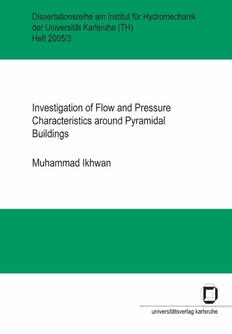
Investigation of flow and pressure characteristics around pyramidal buildings PDF
161 Pages·2009·12.608 MB·English
Most books are stored in the elastic cloud where traffic is expensive. For this reason, we have a limit on daily download.
Preview Investigation of flow and pressure characteristics around pyramidal buildings
Description:
Pyramidal buildings are undergoing a renaissance in today’s architectural design due to their attractive mystery that has fascinated many architects. From an aerodynamic engineering point of view, structural buildings with the shape of a pyramid have their own interesting and particular aerodynamic characteristics as compared to other ‘usual’ structural buildings (i.e. cuboidal). However, despite its distinct aerodynamic characteristics compared to other ‘usual’ structural buildings, the flow and pressure characteristics around pyramidal structures have not yet been investigated completely. Very limited studies about pyramidal buildings can be found in the literature. Consequently, the technical layout with respect to wind load assumption of pyramidal buildings are usually not listed in standard tables which underlines the need of systematic investigations for pyramidal structures. In this study, pyramids with a wide range of base angle variation (theta = 30°, 40°, 45°, 50°, 55°, 60°, 70°) have been investigated intensively through a detailed and accurate laboratory experiments at the Laboratory of Building- and Environmental Aerodynamics, Institute for Hydromechanics, at the University of Karlsruhe. The flow measurements were performed using a 2-D Laser Doppler anemometry (LDA) and The pressure measurements were carried out using a standard pressure tapping technique. The present study focuses on the most important parameters affecting the flow and pressure characteristics that include the influence of base angles, the influence of wind directions and the influence of the pyramid heights with respect to a characteristic length. Besides the experimental investigations, numerical investigations with the aid of a software package called FLOVENT were also additionally performed in order to prove, whether experimental and numerical studies deliver the same results. Based on the flow measurement results, this study was able to distinguish the general characteristics of flow around pyramid building when compared to other type of structures (i.e. cuboidal structure). A set of equations to calculate the reattachment length at the leeward side of the pyramid was generated. In addition, an equation to estimate the zero streamline and an area below line as a function of the reattachment length and base angle, respectively, are proposed. These equations will illustrate the recirculation zone at the leeward side of the pyramid. The pressure measurement results show that the three investigated parameters (base angle, wind direction and pyramid height) have an important influence to the pressure characteristics (magnitude of pressure, suction and fluctuation) in the surfaces of the pyramids. For practical purposes, this study was able to provide the typical values of pressure and aerodynamic coefficients for pyramidal buildings that can be used for structural calculations. The values that are given in this study can be used to fill in the gap of the unavailable design values for pyramidal buildings in standard tables.
See more
The list of books you might like
Most books are stored in the elastic cloud where traffic is expensive. For this reason, we have a limit on daily download.
